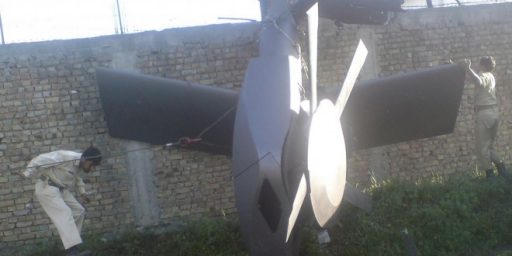Army Helicopter Pilots Training on Ship Landings
Army helicopter pilots get on board with Navy-style landings (Stars & Stripes)
A tiny gray speck grows into the form of a ship before an Army Black Hawk helicopter maneuvers onto the very small deck of the destroyer USS Curtis Wilbur. The small, moving platform, pitching in the wind and waves, is not the usual place for an Army aviator to land. It̢۪s hard enough landing a helicopter. Add movement, a sloping deck and the threat of a vast sea just a few feet away, and the procedure is all the more difficult.
That̢۪s why the Army requires helicopter pilots and crew that operate near water, such as the 78th Aviation Battalion from Camp Zama, Japan, to land on ships. Deck-landing qualifications give aviators more experience and provide a chance for Army and Navy personnel to work together, part of the Defense Department̢۪s push for more joint cooperation. On Thursday, several pilots were scheduled to land aboard the Curtis Wilbur for their qualifications. But after the first landing, the seas became too rough, causing them to cancel the training. But the cancellation demonstrated all the more why landing on a moving seesaw takes practice and skill.
Black Hawk pilots can use that skill to stop off for refueling during long overseas hauls or to medevac a patient. “It gives us operational flexibility,†said Capt. Daniel Rice, operations officer. Navy helicopter pilots do it all the time, but the Black Hawk, configured differently from the Navy’s Sea Hawk, can topple more easily on a rolling deck. “It’s not comparable to Army aviation at all,†Rice said.
The training gives the pilot and crew specific experience, but it helps in other ways as well. A ship at sea has few features around it that would help helicopter crews gauge distance and depth, so deck landings help crew chiefs learn to “see†landings differently. The crew chiefs sit in the back and serve as the pilots’ eyes in the rear and side of the aircraft, so their visual acuity and depth perception is essential. The experience can be applied to other reduced-visibility conditions, such as when operating with night-vision goggles or over desert sand, said crew chief Spc. Jeffrey York.
The training also helps teach the two services to work together. “All the resources out there belong to someone else,†Rice said.
This isn’t absolutely new. Army helicopters went into Haiti on an aircraft career. But it’s about time that joint training on such things became routine.






I don’t think Army helicopters are equipped with ship landing systems. If that is true, then it’s a lot harder for Army pilots to do that than Navy pilots.
This training has been routine for Army chopper pilots for 20 years.
Army choppers on a carrier are one thing, but have you ever seen the video of the C-130 from a carrier??? Now THAT is incredible.
google is your friend.
Training Army chopper pilots to land on the big decks (carriers and amphibs (LHA, etc)) has been going on for quite some time (as Rev Sensing says, 20 years), and has been included in Joint Doctrine.
What is new here is landing on the smaller combatants, such as this DDG. This is a much more difficult job: there are many nearby masts that must be avoided, the landing area isn’t much larger than the helo, plus the ship’s movements are much greater. Indeed, the landing is so difficult that often Navy helos do vertical replenishment (VERTREP) where they hover over the ship and pass the cargo to the ship using a winch and a line, rather than landing.
This is not a simple qualification of learning a few new Navy procedures and terminology (as it mostly is for the big decks), rather this is a much more challenging skill, in which the pilot must keep proficiency. And because of that proficiency need, I doubt most Army helo pilots will get qualified. A few pilots will get qualified (and maintain proficiency) on an as needed basis.
However, there are quite a few more DDGs than there are carriers, so this is a good skill to have available.
My bottom line here is there is a big difference in the skill level between landing on a big deck versus a DDG.